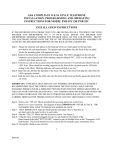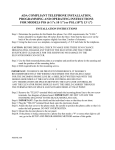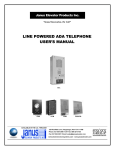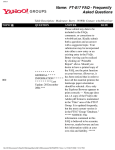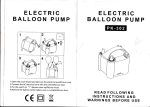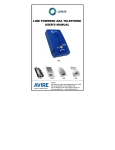Download INSTALLATION, PROGRAMMING AND OPERATING INSTRUCTIONS
Transcript
ADA COMPLIANT BOX STYLE TELEPHONE INSTALLATION, PROGRAMMING AND OPERATING INSTRUCTIONS FOR MODEL PBX INSTALLATION INSTRUCTIONS Step 1. Determine the position for the Hands-free phone in the elevator phone cabinet. Allow enough room at the bottom of the box for opening and removing the cover. Step 2. Using the box bottom as a template, mark screw hole positions in the back of the phone cabinet. CAUTION: BEFORE DRILLING, CHECK TO MAKE SURE THERE IS NO CHANCE DRILLING WILL DAMAGE ANY PART OF THE ELEVATOR AND THAT THERE IS SUFFICIENT CLEARANCE FOR THE SCREWS SO NO DAMAGE TO THE ELEVATOR DOOR CAN OCCUR. Step 3. Drill required holes for elevator phone bottom. Step 4. Mount elevator phone bottom with selected fastener. Step 5. Insert the cabling for the incoming phone line through the slots provided in either end of the elevator phone bottom. IMPORTANT: TO REDUCE OR ELIMINATE ANY POSSIBLE INTERFERENCE, IT IS HIGHLY RECOMMENDED THAT THE WIRING USED INSIDE THE TRAVELING CABLE FOR THE INCOMING PHONE LINE BE A SHIELDED TWISTED PAIR WITH THE SHIELD GROUNDED AT THE ELEVATOR CONTROLLER END ONLY. ANY TERMINATIONS OR SPLICES BETWEEN THE ELEVATOR CONTROLLER AND THE ELEVATOR PHONE SHOULD HAVE THE SHIELD CARRIED THROUGH THE TERMINATION OF SPLICE AND NOT GROUNDED AT THAT POINT. Step 6. Remove the "TELCO" terminal block and attach the incoming phone line to the Telco Block's two screw terminals. See diagram of phone board. IMPORTANT: DO NOT ATTACH THE INCOMING DIALTONE TO THE BLACK MODULAR JACK. Step 7. IMPORTANT: Tape the shield and the individual wires so that they do not short. Step 8. Plug the "TELCO" terminal block back onto the electronics board. CAUTION: WHEN CLOSING THE BOX, BE SURE NOT TO CRIMP THE SPEAKER WIRES, BATTERY WIRES, OR TELEPHONE CABLING BETWEEN THE ELEVATOR PHONE, TOP AND BOTTOM. Step 9. If the phone is being connected to a phone line that needs a "9" or some other digit to call out, go to the SETUP AND PROGRAMMING METHOD section of this guide. 1 PBX2.00 PRE- PROGRAMMING INSTRUCTIONS SET-UP METHODS There are three methods of SETTING UP prior to programming the EMS elevator phone. Select the one applicable to your situation as described below. THE TELEPHONE LINE PROVIDED MUST BE A TOUCH-TONE LINE. The EMS elevator telephone can be programmed at any location and then installed in the elevator cab. The phones have non-volatile memory and will not lose programming. A battery is not necessary to retain the programmed phone numbers or voice message. METHOD A: CALLING UP THE INSTALLED ELEVATOR PHONE 1. From any tone phone call the phone number to which the elevator phone is connected. 2. After five rings (OR if the "CALL" button is pressed) the elevator phone will turn on automatically and you will hear a diddle-diddle-diddle sound. NOTE: If there is more than one elevator phone on the same phone line you will need to have someone press the "CALL" button on each elevator phone to program one at a time. 3. Go to the “PROGRAMMING INSTRUCTIONS” section. 4. After programming the phone, you may remotely test the phone. The test will make sure the phone is functioning correctly and as programmed. See STEP 7 in “PROGRAMMING INSTRUCTIONS”. METHOD B: SET UP FOR PROGRAMMING WITHOUT A PHONE LINE 1. Connect the 9 volt battery to the battery connector. See diagram of phone board. 2. Plug a tone phone into the black modular jack. See diagram of phone board. 3. Unplug the speaker. See diagram of phone board. 4. Using a small screwdriver briefly short out the two pins at "M3" or briefly short the two leads at "CH". Shorting at “CH” will give you an audible tone. See diagram of phone board. 5 Turn the elevator phone over so you can see the front and PRESS the "CALL" button. 6. Make sure that the red light on the front of the elevator phone turns on. If it does not, go back to step 4 and start again. 7. Pick up the tone phone handset and listen for the elevator phone to dial. 8. Two seconds after the elevator phone dials you will normally hear a tone, a two second pause and a pre-recorded voice message will begin cycling with a tone at the end of the message. IF YOU DO NOT HEAR A VOICE MESSAGE, IT MAY MEAN THAT THE PHONE IS SET UP TO NOT PLAY THE VOICE MESSAGE OR TO DELAY THE VOICE MESSAGE 9. On the tone phone enter 1 immediately after you hear the tone at the end of the message. If there is no message, do not enter 1. 10. Listen to the handset and make sure the message is not cycling. 11. REFER TO THE PROGRAMMING INSTRUCTIONS, after programming, return to step 12. 12. Reconnect the elevator phone speaker. 13. Unplug 9 volt battery. 14. Unplug tone phone and test the phone completely. 2 PBX2.00 METHOD C: SET-UP FOR REMOTE PROGRAMMING WITH INSTALLER ON-SITE The elevator phone installer or the off-site programmer can do the programming. 1. Connect elevator phone by wiring phone line to "TELCO" block. See diagram of phone board. 2. Connect the 9 volt battery to the battery connector. See diagram of phone board. 3. Plug the tone phone into the black modular jack. See diagram of phone board. 4. Unplug the speaker. See diagram of phone board. 5. Turn the elevator phone over so you can see the front of the phone. 6. Using the tone phone dial the phone number of the person doing the programming. 7. When you have the off-site person on the phone line press the "CALL" button. 8. Make sure that the red light turns on. Both the installer and the programmer will hear the phone dial. 9. Two seconds after the elevator phone dials both of you will hear a tone, a two second pause then a cycling pre-recorded voice message. IF YOU DO NOT HEAR A VOICE MESSAGE, IT MAY MEAN THAT THE PHONE IS SET UP TO NOT PLAY THE VOICE MESSAGE OR TO DELAY THE VOICE MESSAGE (Voice Mode 5). 10. Either the installer or the programmer should press a "1" irnrnediately after the tone at the end of the message. If there is no message, do not press "1". 11. The voice message should stop cycling. 12. GO TO PROGRAMMING INSTRUCTIONS and return to next step. NOTE: After programming, the installer and programmer will still be able to talk even though the elevator phone has turned off. 13. After the installer finishes talking to the programmer, the installer should unplug the tone phone from the elevator phone. 14. Reconnect the elevator phone speaker. See diagram of phone board. 15. Unplug 9 volt battery. See diagram of phone board. 16. Test the phone completely. 3 PBX2.00 PROGRAMMING INSTRUCTIONS Step 1. Using the tone phone keypad enter # 94851. Listen for three beeps and note that the red LED will be blinking. NOTE ONE: Enter tone digits slowly and deliberately. Too slow, it ignores tones and too fast, it can't read tones. NOTE TWO: Once you are in programming mode, you can perform any programming step in any sequence as long as you get three beeps after your programming entry. Step 2. Enter # 0 (enter the first phone number to be programmed) followed by * #. Listen for three beeps. EXAMPLE: # 05551212 * #. NOTE: If you are on a phone line that requires a "9" or another digit to call the answering service, enter a # after the 9. This will give the internal phone system time to connect to the outside phone line by inserting a 4 second pause. EXAMPLE: # 09 # 551212 * #. Step 3. Enter # 1 (enter the second telephone number to be programmed) followed by * #. EXAMPLE: # 18881212 * #. If a second number is not needed, enter # 1* #. Listen for three beeps. Step 4. Enter # 2 (enter the third telephone number to be programmed) followed by * #. Listen for three beeps. If a third telephone number is not to be programmed, enter # 2 * #. Listen for three beeps. Step 5. Enter # 3 (enter the fourth telephone number to be programmed) followed by * #. Listen for three beeps. If a fourth telephone number is not to be programmed, enter # 3 * #. Listen for three beeps. Step 6. Enter # 7 and listen for the single beep. At the beep, record the location message by speaking into the tone phone handset. Immediately at the end of recording the voice message enter 0. The voice message will play back for you and then you will hear three beeps. The maximum length of location message is nine seconds. If you need to modify the location message enter # 7 and re-record. If you want to listen to the location message without changing it, enter # 8. Step 7. If you want to test the programming and operation of the phone, you can enter * #. The phone will turn off and then (2) two seconds later, it will turn on automatically. The phone will automatically dial the pre-programmed phone number(s) and play the location message. You may want to alert the person receiving the call that this is a test. Step 8. Enter # #. You will hear a beep and the elevator phone will turn off. RETURN TO THE SETUP STEP IN PREVIOUS SECTION. Step 9. After installation, test phone completely. 4 PBX2.00 OPTIONAL PROGRAMMING INSTRUCTIONS TO DISABLE THE VOICE PROMPT MESSAGE AND DELAY THE VOICE LOCATION MESSAGE: To disable the voice prompt from giving the following message: "At the tone press one to talk, press two for location", but delay the location message. Enter # 94851, listen for three beeps. Enter # * 1180185 * #, listen for three beeps. Enter # # TO DISABLE THE VOICE PROMPT MESSAGE: To disable the voice prompt from giving the following message: “At the tone press one to talk, press two for location”. Enter # 94851, listen for three beeps. Enter # * 1180180 * #, listen for three beeps. Enter # # TO ENABLE VOICE PROMPT MESSAGE: To enable the voice prompt message to say: "At the tone press one to talk, press two for location" Enter # 94851, listen for three beeps Enter # * 1180181 * #, listen for three beeps. PROGRAM LOCATION MESSAGE (SEE STEP 6 IN PROGRAMMING INSTRUCTIONS) Enter # # TO ELIMINATE AUTODIALING: Enter # 94851, listen for three beeps. Enter # 0 * #, listen for three beeps, enter # 1 * #, listen for three beeps. Enter # 2 * #, listen for three beeps, enter # 3 * #, listen for three beeps. Enter # # 5 PBX2.00 INSTALLING MULTIPLE EMS TELEPHONES ON THE SAME TELEPHONE LINE Up to eight (8) EMS telephones can be installed on the same telephone line following the guidelines below. When multiple EMS telephones are to share the same telephone line, programming of the set-up code and the use of power packs will be necessary. Power packs are needed when three or more EMS phones share the same telephone line. Power packs can be ordered as an option and are easy to install. The EMS telephone has a set-up code that is programmed when multiple EMS telephones (up to 8) are installed on the same telephone line. This feature is used to communicate with a specific telephone when multiple EMS telephones are connected to the same telephone line. This feature allows the operator to enter an identification number of the specific telephone the operator needs to communicate with. All other EMS telephones will shut off (hang up). TO PROGRAM: 1. Using the programming instructions, enter the programming mode on an individual telephone (# 94851). 2. When in programming mode, enter the following setup code: # * 1180181 * #, there will be three short tones. 3. Enter # #, you will hear a single tone. 4. Hang up. IMPORTANT: The digit 8 (default), shown as bold type in the setup code, is the 6th digit in the sequence and represents the number the telephone will be in reference to other EMS telephones connected to the same telephone line. Each EMS telephone should be programmed with a different number (1 to 8) in relation to each other. Example: Elevator 1: # * 1180111 * # Elevator 2: # * 1180121 * # OPERATION: When a call is made and multiple EMS telephones are connected to the same telephone line, all EMS telephones on this line will answer. Press * followed by the number (1to 8) of the phone you wish to communicate with, all other EMS telephones will then turn off (hang up). 6 PBX2.00 OPERATING INSTRUCTIONS A: TRAPPED PASSENGER CALLING OUT 1. Passenger presses "CALL" button. Red LED on elevator phone turns on. 2. Passenger hears dialtone and dialing of first phone number. 3. Passenger hears ringing intermittently. NOTE: TWO WAY VOICE COMMUNICATION WILL BE ESTABLISHED AFTER THE OPERATOR ENTERS A DIGIT ON THEIR TONE PHONE. 4. Passenger hears a tone two seconds after elevator phone dials and every 7 seconds until the operator responds to the call. 5. If first phone number is not answered within approximately 50 seconds, the elevator phone will hang up and dial the second phone number. The same sequence of events will occur. 6. Once the receiving operator responds to the call with a tone digit the passenger and the operator will be able to communicate. 7. After the red LED begins to blink, the operator can request the passenger to press the "CALL" button again. This action will send an audible signal to the operator to let operator know that someone is actually stuck in the elevator and not just a prank call. This action is normally only important for someone who cannot speak. B: RESPONDING OPERATOR-WITH PROMPT MESSAGE ENABLED 1. Operator hears ringing of incoming call from elevator and answers call. 2. Operator hears a cycling message from the elevator phone stating "ELEVATOR CALL, AT THE TONE PRESS ONE TO TALK, PRESS TWO FOR LOCATION". The message will keep repeating until the operator press a "1" or "2" after the tone on their tone phone. 3. The passenger does not hear any voice messages. 4. Normally the operator should press "1" after the tone at the end of the message to quickly establish two way voice communication with the trapped passenger. 5. At any time the operator can press "2" to hear the location of the elevator. 6. In elevators with a lot of background noise, the operator can press # to mute the microphone. Entry of any other digit will re-enable the microphone. 7. At the end of the location message another message will be heard by the operator that says: "PRESS ZERO TO ALERT PASSENGER OF RESCUE." 8. When the operator presses "0" on their tone phone they will hear three beeps. the Red light on the elevator phone will begin blinking. At this time the passenger knows that the call has been received because wording printed on the phone box states “Blinking Indicates Call Answered Help Is On The Way". 9. The operator can request that the passenger press the "CALL" button again. If the passenger presses the button the operator will hear a diddle-diddle-diddle sound. For the operator, this means that there is a passenger in the elevator. 10. Prior to the phone turning off (normally 3 minutes), the operator will hear this message twice: "TO AVOID DISCONNECT PRESS THREE NOW". 7 PBX2.00 11. If the operator presses "3" on their tone phone within ten seconds after this message, the elevator phone will stay on for another three minutes. The message will be repeated every three minutes for the duration of the call so that the operator can keep the passenger on the line until help arrives or as long as needed. 12. Operator presses *0 to hang up the elevator phone. ALTERNATE B-WITH DELAYED LOCATION MESSAGE -VOICE MODE 5 ALL OPERATING STEPS ARE THE SAME EXCEPT: 1. Operator answers incoming call and begins talking to passenger. 2. Seventeen seconds after the call is dialed, the operator will hear the location message followed by this message: "PRESS ZERO TO ALERT PASSENGER OF RESCUE." 3. Both messages will repeat every 20 seconds until the operator enters "0". C. OPERATOR CALLING INTO ELEVATOR PHONE 1. Operator dials the phone number of the elevator phone and hears ringing. 2. After five rings the elevator phone turns on automatically and operator will hear diddle-diddlediddle sound. 3. At this time the operator and passenger can talk. All other operations stay the same. 4. Operator presses *0 to hang up the elevator phone. D. PASSENGER RECEIVING CALL FROM OPERATOR 1. Passenger hears elevator phone ringing. Phone turns on automatically after 5 rings, OR 2. Passenger can push the "CALL" button to turn elevator phone on. 3. When elevator phone turns on the passenger and operator can communicate. 8 PBX2.00 BATTERY INFORMATION The following information is how to determine when a battery or power pack is needed and the use of different types of batteries. For uninterrupted service, use the following guidelines: You will need a 9VDC battery or a power pack when: 1. The phone will be programmed on site using a portable phone plugged into the black jack on the back of the phone board. 2. The phone drops off the telephone line without completing the call. 3. There is more than one phone on the same telephone line and there is a need to call back to a specific elevator phone, or if all elevator phones need to be “ON” at the same time. For testing, any fully charged 9 volt battery can be used. ALKALINE BATTERY: Can be used on all phone lines. The battery will need to be checked every 6 months. An AC connection is not required and the battery cannot be trickle charged. LITHIUM BATTERY: Can be used on all phone lines. The battery will need to be checked every 6 months. An AC connection is not required and the battery cannot be trickle charged. POWER PAK: Can be used on all phone lines. The Ni-Cad battery in the power pack will need to be checked every 6 months. NI-CAD BATTERY: Can be used only on internal phone systems or when the optional power pack is used. Internal phone system usually require an access digit such as a “9” to obtain a telephone line to allow dialing to a phone number outside the building. Note: For the Ni-Cad battery to maintain its charge, you must place a shorting jumper over the two pins labeled “BC”. The Ni-Cad battery will need to be checked every 6 months. See diagram. 9 PBX2.00 ELECTRONIC MICRO SYSTEMS INC. 125 Ricefield Lane Hauppauge, NY 11788 631-864-4742, 800-333-3671 Fax: 631-864-4770, 888-333-3671 FCC INFORMATION The HFP2.6 complies with Part 68 of the FCC Rules. The label affixed to this equipment contains, among other information, the FCC Registration Number and Ringer Equivalence Number (REN) for this equipment. You must, upon request, provide this information to your telephone company. The REN is useful to determine the quantity of devices you may connect to your telephone line and still have all of those devices ring when your telephone number is called. In most, but not all areas, the sum of the REN's of all devices connected to one line should not exceed five (5.0). To be certain of the number of devices you may connect to your line, as determined by the REN, you should contact your local telephone company to determine the maximum REN for your calling area. The following jacks must be ordered from the telephone company in order to interconnect this equipment with the public communication network: RJ11. An FCC compliant telephone cord and modular plug is provided with this equipment. This equipment is designed to be connected to the telephone network or premises wiring using a compatible modular jack which is part 68 compliant. See Installation Instructions for details. If this device causes harm to the telephone network, the Telephone Company may discontinue your service temporarily. If possible, they will notify you in advance. But if advance notice is not practical you will be notified as soon as possible. You will be informed of your right to file a complaint with the FCC. Your telephone company may make changes in its facilities, equipment, operations or procedures that could affect the proper functioning of your equipment. If they do, you will be notified in advance to give you an opportunity to maintain uninterrupted telephone service. 10 PBX2.00 SPECIFICATIONS FOR ALL EMS ELEVATOR PHONES Input connections: One shielded twisted pair communication cable (Shield should be grounded in the traveling cable) Phone line requirements Standard (analog) loop start voice grade tone telephone line, PBX or key system station analog telephone line. Power required on-hook 0 ma Power required off-hook 20 to 30 ma Phone line voltage on-hook 24 to 56.5VDC (nominally 48V DC) Phone line voltage off-hook 8 to 20VDC (nominally 14VDC, min. 8 to 14VDC) Ringing voltage 80 to 120VAC Operational Loop resistance 600 ohms FCC Registration 6HVUSA-25668-TE-T Ringer Equivalency Number 0.2B NOTE: For some PBX systems the power and/or the off-hook sensing capability of the PBX system is affected by long cable runs. On such systems, if the wiring run is over 300 feet, the pair serving the elevator phone may need to be connected to an OPX card in the PBX. 11 PBX2.00 WARRANTY Electronic Micro Systems Inc. warrants its products to be free from defects in materials and workmanship under normal use and service for 12 months from date of purchase. Seller’s obligation shall be limited to repairing or replacing, at its option, free of charge for materials or labor any product which proves defective in materials or workmanship under normal use and service. Seller shall have no obligation under this Limited Warranty or otherwise if the product is altered or improperly repaired or serviced by anyone other than EMS factory service. For warranty service, contact EMS at 631-864-4742 or 800-333-3671. THERE ARE NO WARRANTIES, EXPRESS OR IMPLIED, OF MERCHANTABILITY, OR FITNESS FOR A PARTICULAR PURPOSE OR OTHERWISE, WHICH EXTEND BEYOND THE DESCRIPTION ON THE FACE HEREOF. IN NO CASE SHALL SELLER BE LIABLE TO ANYONE FOR ANY CONSEQUENTIAL OR INCIDENTAL DAMAGES FOR BREACH OF THIS OR ANY OTHER WARRANTY, EXPRESS OR IMPLIED, OR UPON ANY OTHER BASIS OF LIABILITY WHATSOEVER, EVEN IF THE LOSS IS CAUSED BY THE SELLER’S OWN NEGLIGENCE OR FAULT. 12 PBX2.00 INSTRUCTIONS FOR OPERATION (Can be hung on cabinet door) 1. PRESS SILVER "CALL" BUTTON ONCE 2. RED LED WILL TURN ON 3. PHONE WILL DIAL AND BEGIN SENDING PROMPT MESSAGE TO ANSWERING SERVICE 4. BE PATIENT-OPERATORS MAY BE BUSY 5. AFTER YOU HEAR A LOUD AND LONG TONE, YOU WILL BE ABLE TO TALK TO THE OPERATOR 6. WAIT FOR OPERATOR TO ADDRESS YOU 7. IF YOU CANNOT TALK, WHEN THE RED LED STARTS TO FLASH, PRESS THE "CALL" BUTTON AGAIN. 8. IF YOU CANNOT HEAR, REFER TO STEP 7 AND THEN BEGIN TALKING 13 PBX2.00













